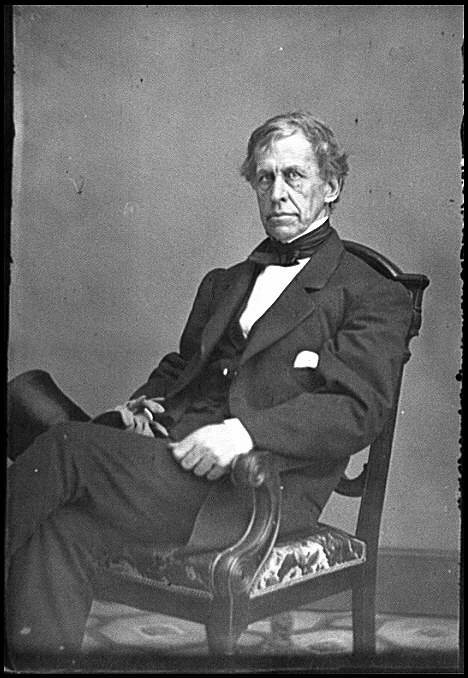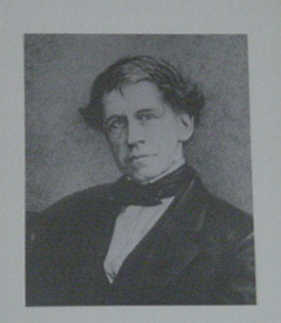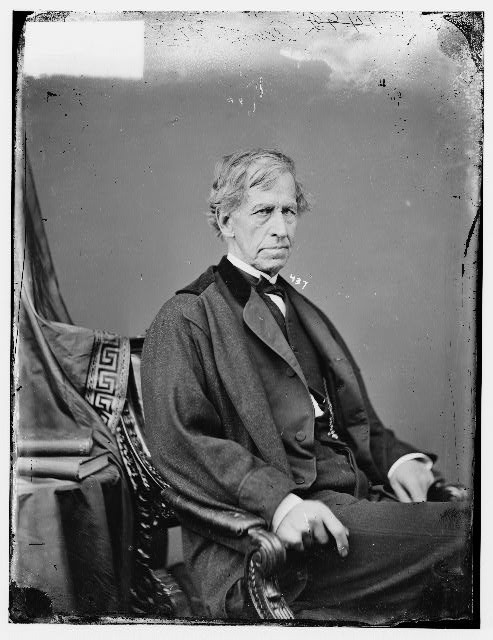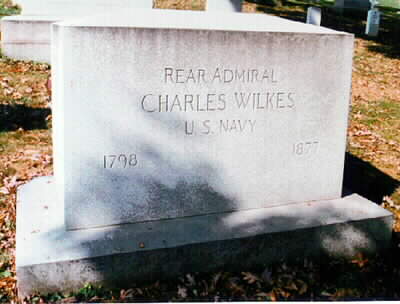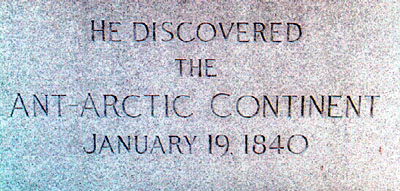Charles Wilkes was born in New York City on April 3, 1798, the son of John De Ponthieu and Mary Seton Wilkes. He was the great-nephew of the celebrated late-18th centry British politician John Wilkes. He was educated at various schools and by various tutors before entering the merchant service in 1815. He married Jane Jeffrey Renwick on April 16, 1826. They had three children. He married again to Mary H. Lynch Bolton on October 3, 1854. They had one child. He died on February 8, 1877 in Washington, D.C. and was buried in Rock Creek Cemetery and reinterred in Arlington National Cemetery in 1920.
He received appointment from New York, January 1, 1818; Captain, September 14, 1855; Commodore, July 16, 1862; acting Rear Admiral, September 15, 1862; promoted to Commodore on July 16, 1862, but rescinded and placed on the retired list with the rank of Captain, November 12, 1862; Rear Admiral on the retired list, July 25, 1866.
He was interested in exploration and studied under the founder of the U.S. Coast Survey, Ferdinand Hasslet. In charge of the new Depot of Charts and Instruments, he began to build a rudimentary astronomical observatory, which became the forerunner of the Nval Observatory. He commanded the very successful U.S. Surveying and Exploration Expedition of 1838-42. In 1847, he was awarded the Founders Medal by the Royal Geographical Society. In 1861 he commanded the USS San Jacinto which stopped the British Steamer Trent in the West Indies, taking off Confederate agents James Mason and John Slidell. Seen by many as a hero, but the “Trent Affair” caused much international tension between the U.S. and England. Holding several more commands during the Civil War, he was subsequently court-martialed for disobedience, disrespect, insubordination and conduct unbecoming an officer owing to his comments against the Secetary of the Navy, Gideon Welles. He was found guilty and sentenced to a public reprimand and suspended for three years, a sentence reduced to one year.
He is buried in Section 2, Grave 1164, of Arlington National Cemetery. A relative, Gilbert Wilkes III, Lieutenant (jg) (1926-2003), United States Navy, and a graduate of the United States Naval Academy is buried in Section 2, Grave 1166. His grandson, John Wilkes, Vice Admiral, United States Navy, is also buried in Arlington National Cemetery. Charles Wilkes, Commander, United States Navy, is buried nearby in Section 2.
Washington, D. C., 8 February, 1877. He entered the United States Navy as a midshipman, 1 January. 1818, and was promoted to Lieutenant, 28 April, 1826. He was appointed to the Department of Charts and Instruments in 1830, and was the first in the United States to set up fixed astronomical instruments and observe with them.
On 18 August, 1838, he sailed from Norfolk, Virginia, in command of a squadron of five vessels and a store-ship, to explore the southern seas. He visited Madeira, the Cape Verd islands, Rio de Janeiro, Tierra del Fuego, Balparaiso, Callao, the Paumotou group, Tahiti, the Samoan group (which he surveyed and explored), Wallis Island, and Sydney in New South Wales.
He left Sydney in December, 1839, and discovered what he thought to be an Antarctic Continent, sailing along vast ice-fields for several weeks.
In 1840 he thoroughly explored the Feejee group, and visited the Hawaiian islands, where he measured intensity of gravity by means of the pendulum on the summit of Mauna Loa. In 1841 he visited the northwestern coast of America and Columbia and Sacramento rivers, and on 1 November set sail from San Francisco, visited Manila, Sooloo, Borneo, Singapore, the Cape of Good Hope, and St. Helena, and cast anchor at New York on 10 June, 1842.
Charges preferred against him by some of his officers were investigated by a court-martial, and he was acquitted of all except illegally punishing some of his crew, for which he was reprimanded.
He served on the coast survey in 1842-1843, was promoted to Commander, 13 July, 1843, and employed in connection with the report on the exploring expedition at Washington in 1844-’61. He was commissioned a Captain, 14 September, 1855, and when the civil war opened was placed in command of the steamer “San Jacinto” in 1861 and sailed in pursuit of the Confederate privateer “Sumter.”
On 8 November, 1861, he intercepted at sea the English mail-steamer ” Trent,” bound from Havana to St. Thomas, Wisconsin, and sent Lieutenant Donald M. Fairfax on board to bring off the Confederate commissioners, John Slidell and James M. Mason, with their secretaries. The officials were removed to the “San Jacinto,” in which they were taken to Fort Warren, in Boston harbor.
The Navy Department gave Captain Wilkes an emphatic commendation; congress passed a resolution of thanks, and his act caused great rejoicing throughout the north, where he was the hero of the hour. But on the demand of the British government that Mason and Slidell should be given up, Secretary Seward complied, saying in his despatch that, although the commissioners and their papers were contraband of war, and therefore Wilkes was right in capturing them, he should have taken the “Trent” into port as a prize for adjudication. As he had failed to do so, and had constituted himself a judge in the matter, to approve his act would be to sanction the “right of search,” which had always been denied by the United States government. The prisoners were therefore released.
In 1862 Wilkes commanded the James river flotilla, and shelled City Point. He was promoted to commodore, 16 July, 1862, and took charge of a Special Squadron in the West Indies. He was placed on the retired list because of age, 25 June, 1864, and promoted to Rear Admiral on the retired list, 25 July, 1866. For his services to science as an explorer he received a gold medal from the Geographical society of London.
The reports of the Wilkes exploring expedition were to consist of twenty-eight quarto volumes, but nine of these were not completed. Of those that were published, Captain Wilkes was the author of the ” Narrative” of the expedition (6 vols., 4to, also 5 vols., 8vo, Philadelphia, 1845; abridged ed., New York, 1851), and the volumes on ” Meteorology” and “Hydrography.” Admiral Wilkes was also the author of ” Western America, including California and Oregon” (Philadelphia, 1849), and “Theory of the Winds” (New York, 1856).
WILKES, CHAS
REAR ADML USN
- VETERAN SERVICE DATES: Unknown
- DATE OF DEATH: 02/08/1877
- DATE OF INTERMENT: Unknown
- BURIED AT: SITE 1164
ARLINGTON NATIONAL CEMETERY
WILKES, JANE D/O CHARLES
- DATE OF DEATH: 08/17/1921
- DATE OF INTERMENT: Unknown
- BURIED AT: SITE 1164
ARLINGTON NATIONAL CEMETERY - DAUGHTER OF CHARLES WILKES – REAR ADMIRAL USN
Michael Robert Patterson was born in Arlington and is the son of a former officer of the US Army. So it was no wonder that sooner or later his interests drew him to American history and especially to American military history. Many of his articles can be found on renowned portals like the New York Times, Washingtonpost or Wikipedia.
Reviewed by: Michael Howard

